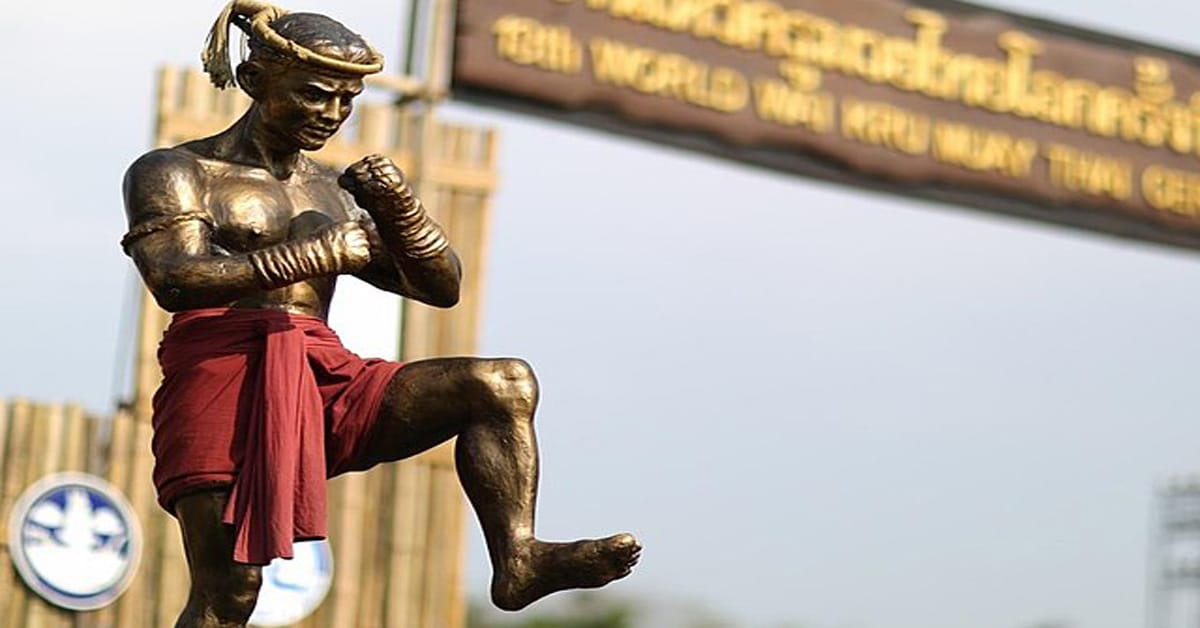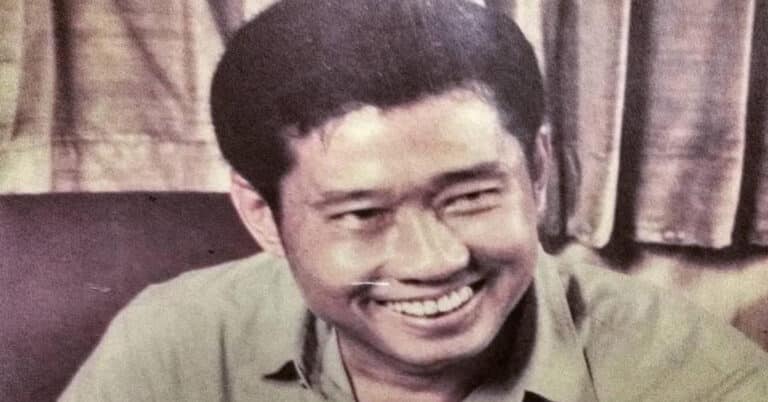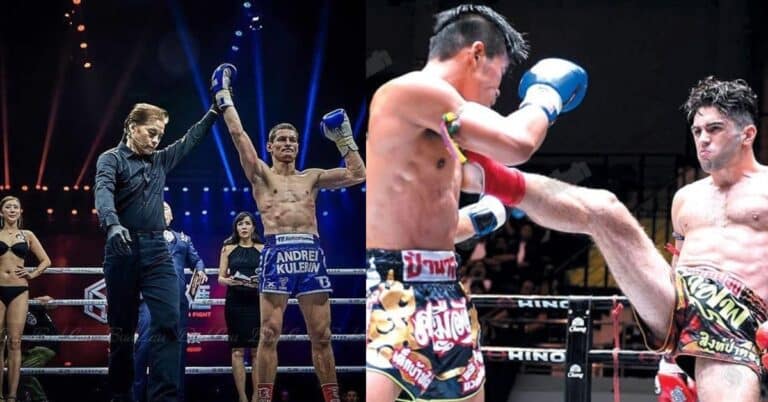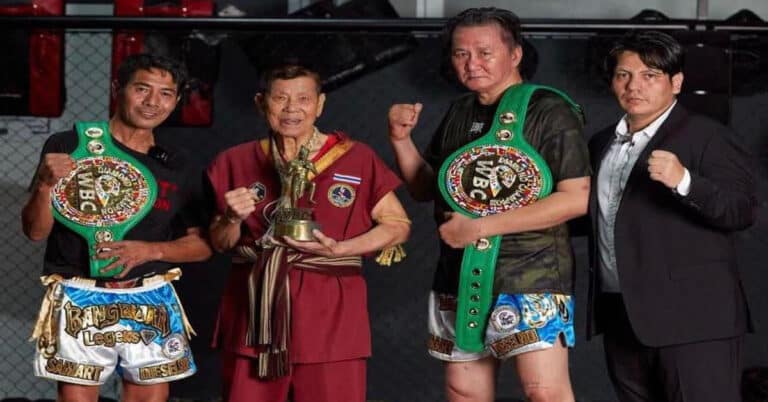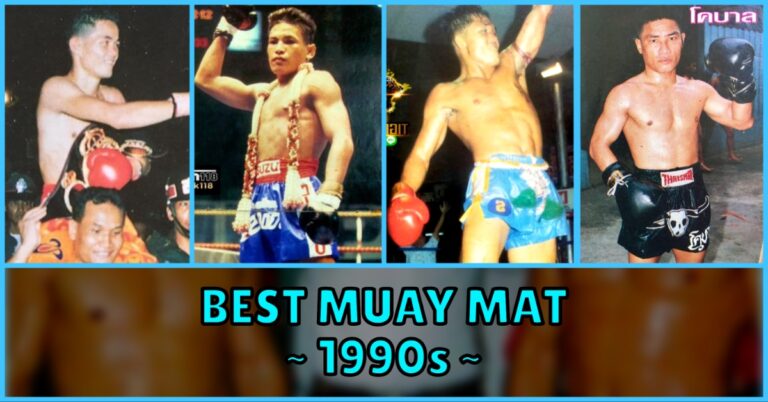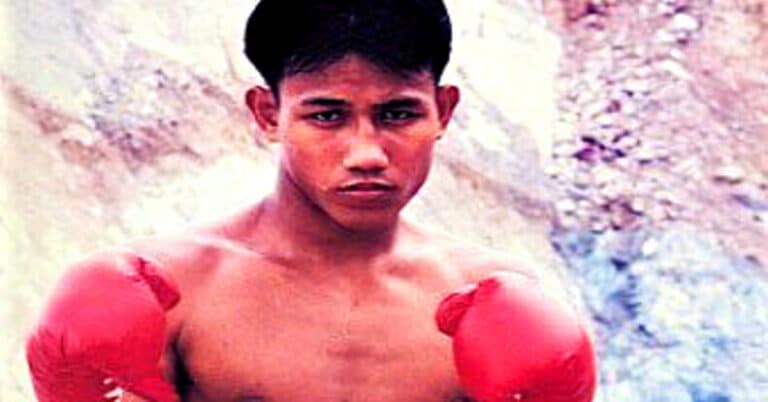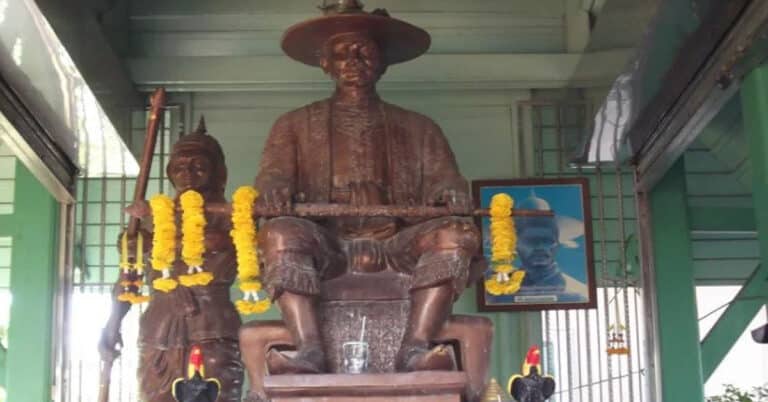Nai Khanom Tom: The Father of Muay Thai
Who is Nai Khanom Tom: The Father of Muay Thai? He is a legendary figure in Thai and Muay Thai history. He was an expert in Muay Boran, the ancient form of Muay Thai, that was often used on the battlefield.
Nai Khanom Tom is an icon who has statues dedicated to him around Thailand and even has a national day devoted to him on March 17. This athlete and fighter have so much renown that Muay Thai greats such as Rodtang Jitmuangnon both cite him as one of their greatest inspirations.
The Legend of Nai Khanom Tom
Nai Khanom Tom, renowned as the patriarch of Muay Thai, stands as an iconic figure in the annals of this martial art’s history. His legend is intertwined with the tumultuous backdrop of the Second Burmese–Siamese War (1765–1767), where he found himself a captive of the Burmese military.
During this period, King Mangra of Burma orchestrated a grand festivity to commemorate the construction of a new Buddhist temple. Within this celebration, an intriguing spectacle unfolded as Mangra pitted one of his finest Burmese fighters against the formidable Thai pugilist, Nai Khanom Tom. Prior to the commencement of the bout, Nai Khanom Tom executed an intricate dance, a precursor to the modern Wai Kru, that has persisted through time. His rhythmic movements encompassed the arena, accompanied by a fervent prayer.
In an astonishing display of prowess, Nai Khanom Tom effortlessly vanquished his Burmese adversary. However, the match’s arbiter discounted the victory, attributing it to the purported distraction caused by the dance and prayer. Undeterred, Nai Khanom Tom courageously engaged in successive battles against nine more Burmese opponents, conquering each one, including a heralded regional kickboxing champion. It was his adept integration of punches, kicks, elbows, and knees that cemented his triumph.
Resonating through the ages, King Mangra lauded, “Every part of the Thai is blessed with venom even with his bare hands he can fell ten opponents.”
Acknowledging his extraordinary skills, King Mangra granted Nai Khanom Tom his liberty and extended the choice of wealth or multiple wives as a reward. Electing the latter, the Muay Boran luminary Nai Khanom Tom quipped that wealth could be acquired at any juncture.
Although various renditions of this narrative exist, the tale of Nai Khanom Tom stands as the cornerstone from which Muay Thai derives its origins. A yearly commemoration in his honor and numerous statues throughout Thailand attest to his enduring legacy. Undoubtedly, he is the preeminent luminary among the pantheon of Muay Thai legends.
There are some terms in this story that readers may want an explainer for. See below for further details.
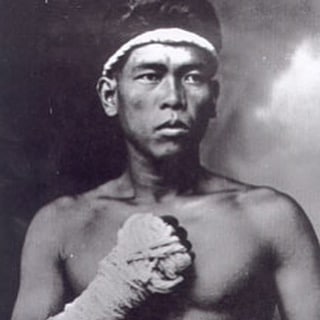
What is Muay Boran?
Muay Boran is the ancestral precursor to modern Muay Thai, encompassing a broader array of martial techniques and strategies developed for combat and survival in historical contexts. Muay Boran is an umbrella term for any martial arts practiced in Thailand pre-twentieth century.
Muay Boran includes various styles such as Muay Korat, Muay Lopburi, Krabi Krabong, Muay Chaiya, among others.
Muay Boran, sometimes referred to simply as “Boran,” is an ancient and traditional form of Thai martial arts that predates the modern sport of Muay Thai. Muay Boran encompasses a wide range of techniques, including strikes, grappling, throws, and joint locks. It has historical roots in warfare and self-defense, having been developed and practiced by Thai warriors for centuries.
The term “Muay Boran” translates to “ancient boxing” or “traditional boxing” in Thai. It was originally designed for combat and survival on the battlefield, where soldiers needed effective skills to defend themselves in hand-to-hand combat. Over time, the techniques and strategies of Muay Boran evolved and were passed down through generations.
Muay Boran gradually transformed into the modern sport of Muay Thai, which emphasizes competition and sportive aspects. Muay Thai streamlined and adapted many techniques from Muay Boran into a more standardized and regulated form of combat sport, focusing on striking with fists, elbows, knees, and shins.
Grand Master Chaisawat Tienviboon, recently talked about the distinctions between today’s Muay Thai and Muay Boran. In an interview, he said:
“Old generation of Muay Boran practitioners learnt the Art for real fighting. Muay Boran fighting was “all-out combat”. There was no rule. In learning Muay Boran a modern student must try to learn every detail of each technique he is taught and must try to study all aspects of each maneuver in depth. In fact, he needs to trace back the original roots of all Mai Muay he practices, all the time.”
Muay Thai’s Boran origins can be traced back to the Sukhothai Kingdom era in the 1200s, with the earliest recorded mentions of Boran dating from that time, though its origins likely extend even further into the past.
Although sharing similarities, Muay Thai and Muay Boran possess distinct characteristics. Muay Thai has evolved into a regulated sport with standardized rules, introducing gloves and rings in the 1900s under the auspices of King Rama VII. This marked the point at which combat sports in Thailand prior to the 20th century were designated as Muay Boran.
While both Muay Thai and Boran have their roots in martial traditions, they have transcended their military origins. These combat styles have become emblematic of Thai identity, shaping the lives of individuals across society’s strata, from monarchs to monks, men to women, and even children, all engaging in the practice of close-quarters combat in Thailand.
What is the Wai Kru?
The Wai Kru is a traditional dance done before each Muay Thai matchup and is closely tied to Buddhism. It is a gesture of respect, homage, and mental preparation carried out by fighters before they enter the ring to compete. The Wai Kru is deeply rooted in Thai culture and carries spiritual significance.
During the Wai Kru, fighters pay their respects to their teachers, trainers, and ancestors who have passed down their knowledge and skills. The ritual is also a way to demonstrate gratitude, seek blessings, and mentally focus before the impending match. The movements and gestures performed during the Wai Kru can vary, but they typically involve a series of ritualistic motions, prayers, and offerings.
Legend has it that in ancient times, the Muay Boran period, when contests took place outdoors, this practice also served to assist the fighters in gauging the wind’s direction and placing the sun’s position in the sky. It had a strategic advantage.
It helps fighters connect with their martial arts heritage, their lineage, and the spirits of the art itself. This ritual is a means of invoking a sense of strength, determination, and honor as fighters step into the ring. In modern Muay Thai, the Wai Kru is performed alongside live music.
Muay Thai and Buddhism have other closely tied elements to Buddhism and spirituality such as the Pra Jiad, Mongkon, and Sak Yant.
The Mongkon is a revered element worn by Nak Muay fighters before Muay Thai matches, intimately tied to Thai Buddhism. Its significance lies in its capacity to bestow good fortune, safeguard the wearer during the contest, and instill inner strength. Its historical roots extend for centuries, mirroring the legacy of Thai warriors.
The Pra Jiad, known as Muay Thai armbands, is an element worn by Muay Thai fighters on their biceps during matches. Rooted in Thailand’s heritage, steeped in historical significance, Pra Jiad symbolizes a fighter’s connection to family or gym. These armbands are often blessed by Buddhist monks and, like the Mongkon (headband), must be treated reverently, not touching the ground or being crossed over. They are designed to invoke luck and can be worn during fights.
A Sak Yant tattoo is a sacred and ritualistic tattoo applied and blessed by Buddhist monks. This tattoo is imbued with spiritual significance and is obtained through a ceremonial process that involves a Wai Kru before the tattooing begins.
Followers of Nai Khanom Tom
Nai Khanom Tom still stands as an inspiration for Nak Muays. The ONE Flyweight Muay Thai World Champion ‘The Iron Man’ Rodtang Jitmuangnon, who is a combat sports superstar, discussed his biggest inspirations. He said:
“The legend or someone that I look up to is Nai Khanom Tom, one of the legendary boxers in Thailand, and the other person is Buakaw who inspires me in [Thai] boxing.”
Head trainer at the Fairtex gym, Apidej Sit-Hirun explained in an interview how each child in Thailand is taught about the legend of Nai Khanom Tom when they are young. He explained:
“When I was taught history in school, I learned about a Thai boxer named Nai Khanom-Tom. He was a prisoner of war in Burma but when the Burmese found out that he was a Muay Thai fighter, they let him challenge Burmese fighters. Nai Khanom-Tom won and the Burmese released him.”
Nai Khanom Tom’s legacy stands as an enduring testament to the spirit, skill, and resilience of Muay Thai. Through his remarkable victories in the face of adversity, he not only secured his own freedom but also etched his name in the annals of martial arts history. Nai Khanom Tom has inspired generations of fighters.

